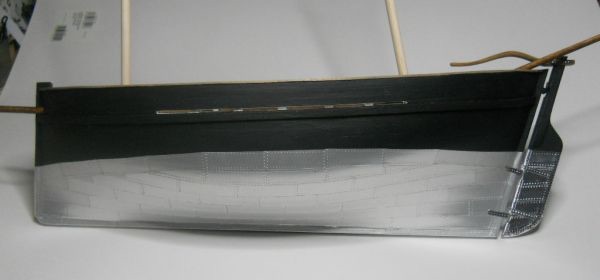-
Posts
134 -
Joined
-
Last visited
Content Type
Profiles
Forums
Gallery
Events
Posts posted by Seamus107
-
-
Just tuned in to this building log for the Bounty launch. Good work so far, looking forward to seeing your progress in future posts.
james
- Keith Black and oakheart
-
 2
2
-
Sometimes I cover about 1/4” of the end of a line with super glue and, when the glue dries, cut the tip at an angle to yield a sharp point. Usually I can then get the stiff, pointed tip through an appropriately sized hole. If the tip bends or frays, I re-cut a new point a little ways back and try again.
james
Maine
- JpR62, thibaultron, Ryland Craze and 1 other
-
 4
4
-
I used a spray product called Dullcoat to make aluminum tape look like zinc, worked fine.
james
- mtaylor, Canute and thibaultron
-
 3
3
-
I like to use Lego blocks when gluing up frames. They are perfect right angles, can be assembled into jigs of various configurations, have good surfaces for clamping, and are resistant to wood glue. For my current model, I glued 28 frames to a false keel, starting at the bow and working toward the stern, one at a time, moving the Lego jig along as I went. Works well for me.
james
Maine
-
The name shown on the bow of the model kit, “James Caird” is not correct. I contacted an archivist at Dulwich College, who confirmed that names were painted on the bows of all three boats salvaged and repaired by Shackleton, and that the name painted on the boat that made the journey to South Georgia was “J Caird”. In one of Frank Hurley’s photographs of the Caird launch from Elephant Island, the name “J Caird” is visible at the bow. The kit manufacturer should correct this error before the kit is made available, if they claim that their model is historically accurate.
james
Maine
- Roger Pellett and mtaylor
-
 2
2
-
I should have been more clear in my initial post. Modelers Central is OFFERING the kit, not making it, as the above comments indicate. I was excited and posted the first news I heard about a James Caird kit, without digging into the details about the kit manufacturer. Sorry about that.
james
Maine
- thibaultron, Ryland Craze and mtaylor
-
 3
3
-
Modelers Central is coming out with a James Caird model kit in 2022. Details (although not many) can be found at https://www.modelerscentral.com/modeling-hub/james-caird/. Looks like a good, realistic representation of the Caird, with a cutaway hull to show ballast, crates, supplies, etc., in the crowded boat.
james
Maine
- Harvey Golden, grsjax, thibaultron and 1 other
-
 4
4
-
I have arrived late to this build, and am impressed with the work done thus far. You do not seem to be afraid to admit mistakes and are clear about how you address them. Very commendable. The Endurance is part of a great Antarctic survival story, and is a truly historic ship. I am looking forward to the next steps.
James
-
-
Chuck,
Did you darken the edges of the planks to define the planking? In some of the closeup shots, it looks like the seams are a little darker than just a shadow. Beautiful planking, regardless.
James
Maine
- thibaultron, EJ_L, mtaylor and 2 others
-
 5
5
-
I am planning a 1/24 scale diorama that will include part of a square-rigger mast and at least one spar, maybe two. Given my chosen scale, It is critical for the sizes of the rigging lines and pulleys to be as accurate as possible. Any suggestions about where to find information about the actual sizes of pulleys and the full-sized diameter of rigging lines on fully-rigged ship would be appreciated. Thanks.
-
-
This is a follow-up to my query about zinc plating.
To simulate zinc plating on my Mount's Bay lugger model, I ended up using aluminum foil tape purchased at a local big-box building supply store. According to the manufacturer, the adhesive on this duct repair tape was good for a wide range of temperatures, from below freezing to well above boiling, so I figured it would sick all right to the smoothed, primed hull of my model. I cut scale rectangles to represent the 14" by 48" plates, and embossed them around the edges using a pounce wheel to represented the nail heads. I realize that this is not quite correct or realistic, since the nail heads would have been flush with the surface of the plates, or even recessed a little, but I felt that the visual effect of slightly raised nails was important to the overall look of the model. The aluminum foil tape was very shiny, but all it took was a spray with Dullcoat to give the plates a pewter-like appearance, close enough to the appearance of zinc plates.
Below is a photo of the hull, after finishing the application of the plates and spraying with Dullcoat. As I worked up from the keel and forward from the stern, I let the plates follow the curve of the hull, but the topmost row was applied along the waterline. In the photo, the rudder is in place, sheathed with foil plates below the waterline to match the hull, but has not yet been sprayed with Dullcoat. The effect of the Dulcoat on the shiny aluminum plates is clearly apparent.
- IgorSky, JerseyCity Frankie, mtaylor and 1 other
-
 4
4
-
I am building a model of the Mystery, a Mount's Bay lugger that sailed from Cornwall to Australia in 1854-55. Apparently the hull was plated with zinc before this voyage. I would appreciate whatever advice MSW members can give me about how best to model zinc plating. Thanks.
James





Where can I get small grommets?
in Masting, rigging and sails
Posted
I am down to the last four mini-grommets from my late father’s ship modeling supplies. Their outer diameter is 3/32, which means the hole is about 1/32. I have looked around for a source to get more, but have had no luck. Any ideas from this very experienced group would be appreciated. Thanks.
james
Maine